It wasn’t that long ago that big-bore nakedbikes were merely stripped-back, detuned versions of a firm’s respective Superbike. A flat ’bar mounted above the triple clamp to ease the backs and wrists of ageing sportsbike nuts. And while the market has changed significantly since the successful ‘win on Sunday, sell on Monday’ days, nakedbikes have remained hugely relevant, in fact, probably more than they’ve ever been.
These days riders require more versatility from their two-wheeled machine; no longer just a Sunday scratcher or a weekend toy, all of a sudden motorcycles are playing an increasingly important role as a cost-effective transport option. Their upright ergonomics make nakedbike offerings both practical and accessible, and their development is no longer restricted to their racetrack-bred forebears.
Which is the reason why Indian’s new FTR 1200 S offering is mixing it with this company. It was never designed to compete directly with a naked BMW Superbike – that’s not what it’s in this group test to do – but at a not-dissimilar price point and capacity, it’s offering a would-be nakedbike owner something really unique and hugely capable.
The BMW represents the Supernaked offerings – the Aprilia Tuonos, the Yamaha MT-10s and soon-to-be unveiled Ducati V4 Streetfighters of this world. The sit-up-and-beg naked Superbikes with pin-sharp handling, WorldSBK-inspired power delivery and top-shelf electronic rider aides.
And then there’s KTM’s stonking 1301cc brute that thumbs its aggressive-looking nose at homologation regulations and derivatives thereof. Much like Triumph’s Speed Triple – arguably the grand-daddy of the nakedbike class – the Super Duke R exists as the hard-edged streetfighter designed to take the Supernakeds head on.
None of these machines are cheap – they’re all well into the mid-to-high 20s (on the road), but they all represent excellent value for money in their own right. If you’re in the market for large-capacity nakedbike, I’m thoroughly envious. But unless you’re a brand loyalist and you’ve already made up your mind, you have a tough but wonderful decision ahead of you.
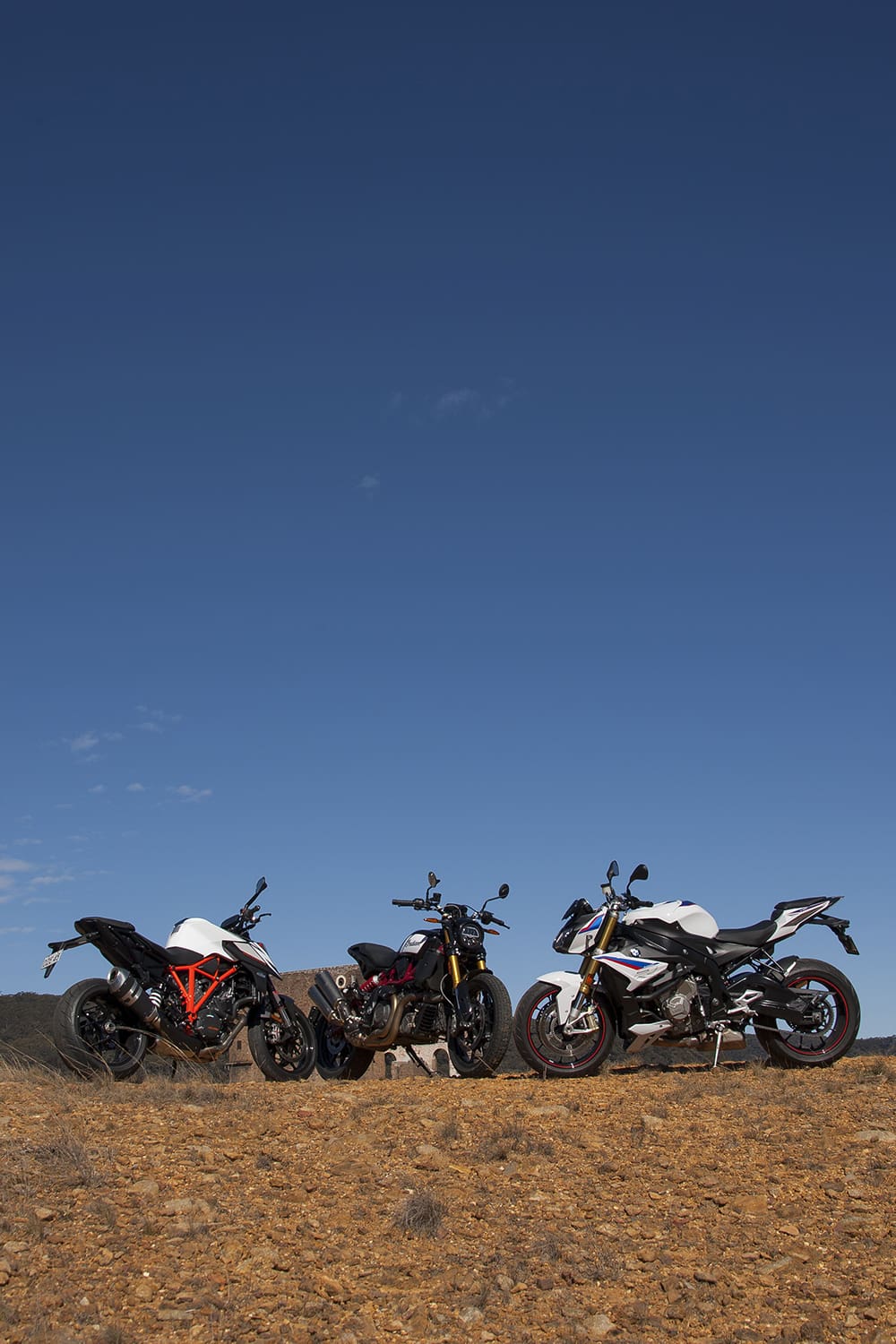
How we did this
Well, how we planned it and how it panned out ended up being two different things. The plan was awesome; meet on the north western fringes of Sydney nice and early, head north to Singleton to take in the excellent Putty Road. We’d grab a quick coffee in Singleton before heading south-west along the fun, fast and flowing Bylong Valley Way through to Rylstone where, as so many AMCN group tests have over the years, we’d have long and robust discussions about the pros and cons of each machine at the warm and welcoming Globe Hotel. From there, we’d begin our ride home via Bathurst in a bid to sample the splendid Sofala road, a short highway run to Lithgow, before heading back to Sydney via the Bell’s Line.
“Let’s just wing it,” said Sam ahead of the test. “Some of my most successful and best trips have been when we haven’t had a plan.”
And we should have listened to him at the start, because as it turned out, the only boxes we ended up ticking on our carefully mapped-out plan was the meeting point, the robust conversations at the bar and a dash along the Bell’s Line home. The combination of a bitterly cold winter morning and a disagreeable bike battery thwarted our well-laid plan, leaving us with no option but to wing it on three of the most coveted nakedbikes out. Which, when put like that, was always going to end well.
What followed was a couple of days of tight and twisty corners, long, flat-out sweepers, bumpy back-roads, highway hot-mix and even a dash of dirt.
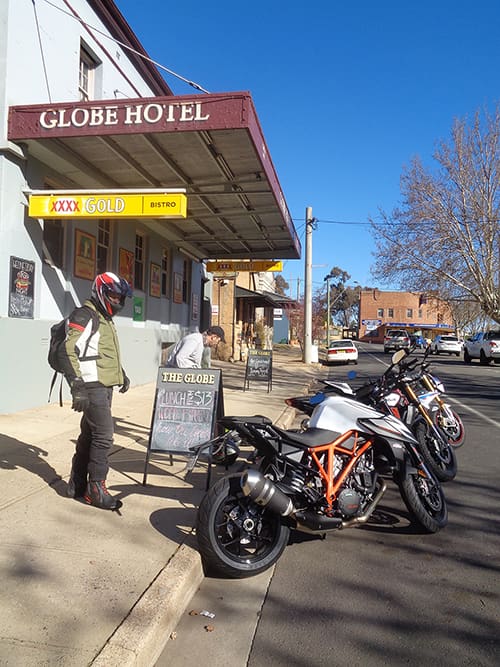
Precision instrument
BMW’s S 1000 R takes the power to the people
The S 1000 R Sport is a bike that does everything well. The Germans have engineered it to within an inch of its life and you may be excused for thinking this level of perfection has made the S 1000 R bland, but you’d be wrong.
The only inline-four cylinder on the test, the S 1000 R could be the poster child for new era versatile fours. The 999cc plant will sedately whir along at 80km/h in sixth, with enough torque at its disposal to simply ‘wind it on’ for most overtaking manoeuvres. Or you can knock it back a couple of cogs with the perfect quickshifter setup, and put sedate behind you. Because there’s nothing sedate about 121kW (165hp) at 11,000rpm (claimed).
Where the KTM wants you to wrestle it through the turns, the BMW goes about fast a different way. It’s the easiest of the trio to push. The S 1000 R spoon feeds you confidence and it’s so smooth and so composed, it’ll have you believing you’re a better rider than you give yourself credit for.
The brakes are outrageously good – which only compounds your confidence – and the four-piston Brembo setup at the front offers unrivalled bite and power. The only downside to the package is the placement of the rear brake pedal, which is too close to the frame, meaning your foot can slip off too easily mid-U-turn.
The riding position is the least comfortable of the trio to cover long distances, though the heated grips and excellent cruise control helps there. As the tallest of the riders (186cm), I find its seating position relatively cramped, with more weight on my wrists than the other two machines. With this, however, comes the lowest seat height of the three bikes, making it the easiest for shorter riders to get along with.
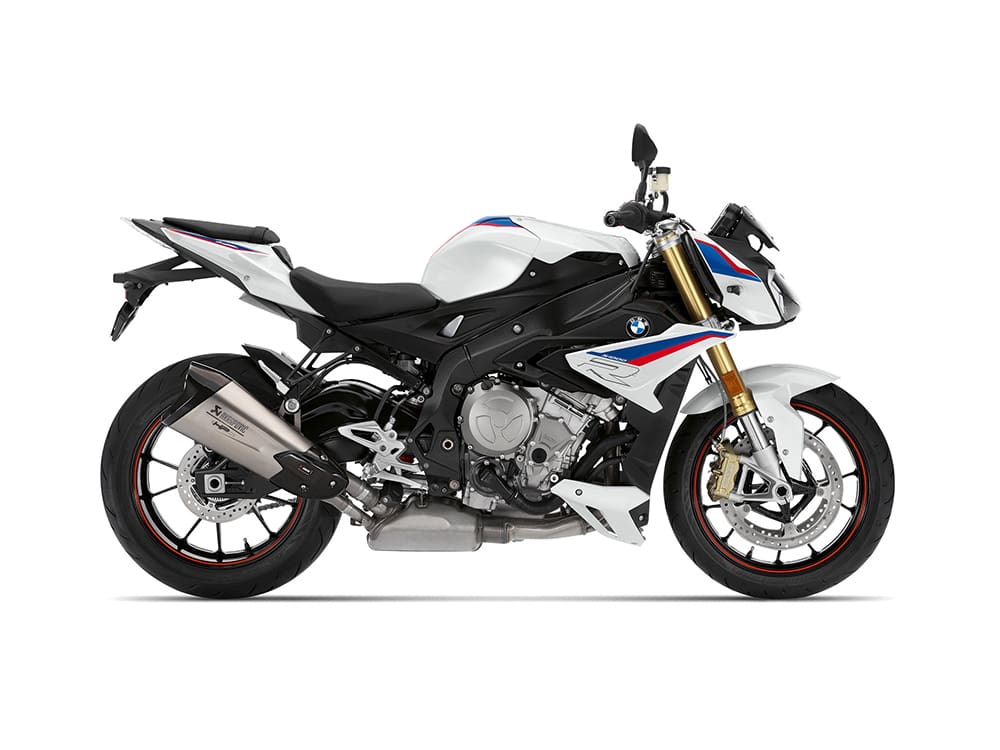
Despite its semi-active suspension – the only bike in this bunch to boast it – its on-track heritage is its shortfall on rough backroads. Even in the plusher ‘Road’ mode, potholes and bumps are fed back at you through the bars and seat with far too much enthusiasm. Bumpy B-roads in ‘Dynamic’ mode is anything but.
With an analogue tacho and small digital display, the Beemer’s dash looks and feels dated compared to the swish, full-colour TFT displays on the Super Duke and FTR. It gives you all the info you need, but it’s small, slightly fiddly and not as easy to read on the fly.
Despite not receiving any significant updates since 2016, the BMW – which is the least expensive of the bunch – still boasts the most tech. Just.
The BMW is equipped with lean-angle sensitive traction control and ABS systems that are flawless, and multiple ride modes and two seperate suspension modes (Dynamic and Road). On top of this, the S 1000 R Sport also includes the best bi-directional quickshifter you’ll ever use, heated grips and other goodies, like an Akrapovic titanium silencer.
Given its age, the S 1000 R Sport is an astoundingly good motorcycle that can hold its own in any company, naked or not. Refined it may be, but boring it is not.

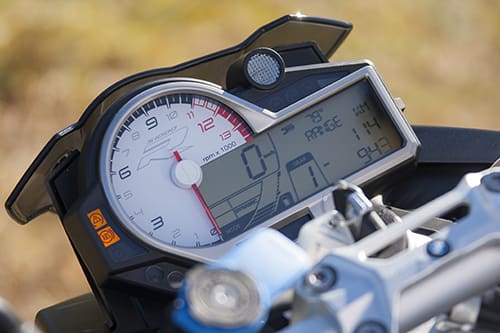
He said, she said
Sam Maclachlan
What does this bike do wrong? Nothing. It has one of the more aggro riding positions for a naked – the KTM feels more natural to me – but everything is so flawless, it’s easy to start thinking it’s a bit vanilla. Then you crack the throttle, squeeze the brakes, change gear or tip into a corner and you know it’s too good, too dynamic to be accused of that flavour. It simply cracks on so many levels, and that powershifter is still the best in the business – as flawless as the rest of the bike’s dynamics. It could do with a TFT dash, but that doesn’t make it any less exciting to ride.
Kel Buckley
I’m always asked what my favourite bike is and I always say it’s impossible to answer – because it is. But, despite being slightly long in the tooth these days, BMW’s S 1000 R is firmly on the shortlist. It’s jammed full of tech, its chassis is to die for – you’ll be hard pressed to find a more precise steerer. Its brakes are astounding, far more than a real-world roadbike needs, but no one’s complaining. It’s compact, it’s hugely predictable and it gives you barrel loads of confidence to ride it hard. And the quickshifter is as good as it gets.

Circular Heritage
Indian’s FTR 1200 is fighting a battle it can’t lose
Indian set out to build a unique bike with real-world usability, but based on the look and feel of its celebrated FTR 750 Flat Tracker. Job done. It isn’t a direct competitor for the BMW and KTM, however Indian’s take on nakedbike awesomeness is alluring enough to sway a rider from the established nakeds to this way of enjoying life without a fairing.
Designed to be neither a naked Superbike nor an aggressive streetfighter, the Indian is the easiest to live with of this group. Its 1203cc V-twin engine spins up slower and its 92kW peak power (claimed) comes in at a practical 8250rpm. Its claimed torque of 118Nm@6000rpm means you can be a bit lazier with the gearbox and the versatile V-twin will pick up the slack. Similar to the BMW, the FTR lets you lope along at very low speeds in top gear and it takes just a twist of throttle to propel you to licence shredding speeds. Turn the traction control off (at standstill only, like the KTM, but unlike the BMW)and the FTR can light up the flat-track inspired Dunlop DT-3 with gobs of torque.
The engine takes forever to warm up in modern terms, and until it’s hot, prone to stalling and surging at constant throttle, though it was near-freezing in the mornings on the test ride (2°C…). The other two fuelled fine in the same conditions.
The FTR carries more weight than the other two machines, but carries it lower than the Beemer. It has a longer wheelbase, too, offering the most stability through fast, bumpy corners. It’s still surprisingly nimble given its 19-inch front and an 18-inch rear wheel set-up and the fully-adjustable Sachs suspension manages the road zits best in this group. Those Dunlops are far grippier than they look, once you adjust to the movement from the blocky tread pattern.

The Brembo brake package is excellent – though not as excellent as the Beemer’s – and the FTR boasts the most feel from the rear stopper, not surprising given its cruiser lineage.
The seat is the taller and wider than both the BMW and Kato. At 186cm tall, the ’peg-seat-’bar relationship is a mite uncomfortable over long distances, whereas my more compact colleagues found it the most comfortable of the three.
The touchscreen TFT display is as good as it gets these days and the best of the bunch. It’s as savvy and as intuitive as your smartphone, operable either by its touchscreen with a gloved finger or by bar-mounted controls.
The footpeg placement makes the sidestand overly difficult to operate – it’s easier to get off the bike first, then swing it into place. Not ideal. The chequered-patterned grips are harsh to hold, too.
Indian has created a very cool and unique looking motorcycle, which is what allows it to face up to the BMW and KTM in a showroom battle. It isn’t as fast, but it’s just as enjoyable – except in fuel range terms. A two litre larger tank thanks, Indian!
Unlike some theme-inspired creations, though, it stops, handles and goes like a modern bike should, and while there is little in direct competition to it, it’s worth considering when it’s new naked bike time.
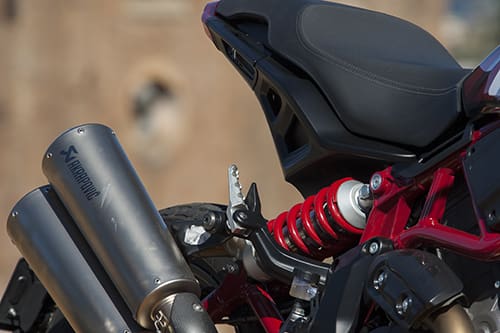

He said, she said
Sam Maclachlan
Nakedbikes have to be fun, and if you can’t have fun on this thing, hand in your bike licence right now. The Race Replica looks amazing, even if the price to get it that way is too steep in my opinion, but the power delivery, looks, ride position and excellent TFT dash all make each time you climb aboard fun and involving. The sidestand operation from the seat is a shocker, the seat height a little too high and the bike takes a long time to warm up and run smooth for a modern bike, but none of these aspects took away from the ride for me. I had a ball on this bike.
Kel Buckley
Easily the best looking of the bunch, its longer wheelbase and larger-diameter wheels are immediately noticeable through a slower-steering, but far more stable and relaxed ride. I found the full-colour TFT touchscreen dash the easiest of the three to both read and navigate. Oozing with personality, the engine is punchy but predictable, and the seat is not only the tallest of the lot, but also the widest, making it difficult for shorties like me to lift off the stand if parked carelessly. Would I still own one? You bet.
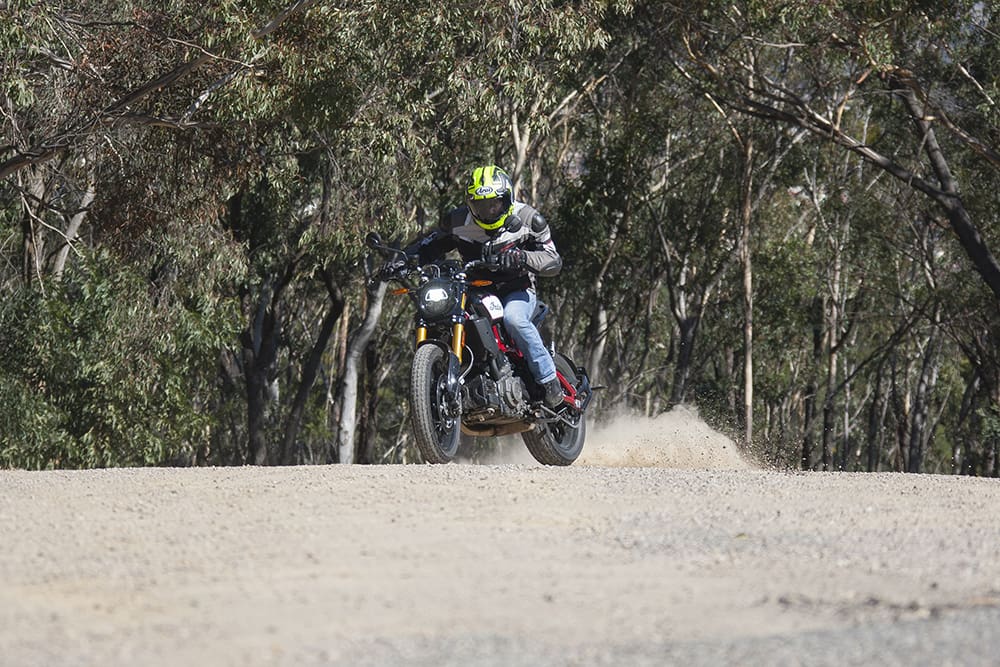
ZERO APOLOGIES
KTM’s brawling v-twin will run a shock and awe campaign on your senses
Where the S 1000 R is all refinement and grace, the Super Duke R is venom and bile. It’s the unruly but charismatic kid next door who’s clever and cunning in equal parts – and hugely capable.
Like the FTR, the Super Duke runs a V-twin engine, but that’s where the similarities end. The KTM extracts its claimed 130kW from the whopping 1301cc 75º engine in a very different manner. It spins up fast, and seems to have endless power all the way through the rev range. It’s an excellent road bike engine.
The gearing is too tall: at 80km/h it’s revving too high for fourth and too low for fifth. And it’s the same story at 100km/h, with the happy spot being somewhere between fifth and sixth. Sure, you could drop a tooth on the front sprocket but its proclivity for wheelies already borders on licence-losing lunacy.
The Super Duke’s front end gives excellent feedback, and it’s very stable. Boasting WP’s fully adjustable 48mm front fork, it wants you to wrestle it through the turns. Not because it’s a slow steerer, it just likes lots of input from a thoroughly engaged rider.
Like the S 1000 R, the Super Duke runs ABS-equipped twin 320mm discs with Brembo Monobloc four-piston calipers up front, but despite the similar spec, and the 10-kilo weight advantage over the BMW, the Super Duke lacks the bite and power of the BMW’s brakes. This isn’t a shortfall of the Super Duke, just an illustration of how damn good the BMW’s package is.

Despite – or perhaps because of – the Super Duke’s unconventional looks, it’s very comfortable. Multiple hour stints in the saddle are easy, with very little pressure on the wrists, and the top-spec suspension does a great job of soaking up crater-littered roads. The 835mm seat height puts shorter riders on tippy toes, but the skinny seat and narrow waist, isn’t as restrictive as the taller FTR seat.
The TFT display is probably as good as the Indian’s in terms of capability and intuitiveness, but its auto-switching day/night mode is too sensitive – cruising dappled-light roads has the dash flashing like a strobe light.
The Super Duke comes with cornering ABS and traction control and it boasts stability control and switchable rider modes. But when compared with the S 1000 R Sport, which comes loaded with heated grips, semi-active suspension and a quickshifter – and is significantly cheaper – you have to love its character to justify the extra clams.
That character is what makes it shine in this company; it absolutely lights a fire under your butt in a way few other bikes do. It might lack a little finesse and some of the fruit of the S 1000 R and FTR, but compensates with an attitude – underlined by that engine – that’s sure to bring out your inner ratbag, and yet is still comfortable on long rides. Like the Indian and BMW, it goes about being naked in a way all its own – just get on, shut up and hang on. It’s unapologetically loose, in a really, really good way!
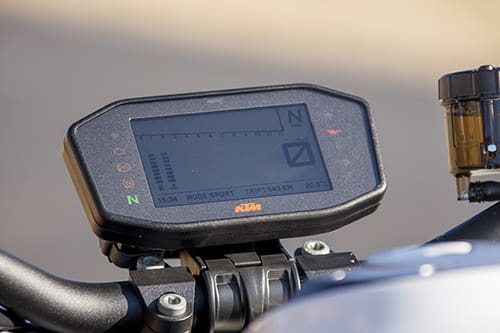
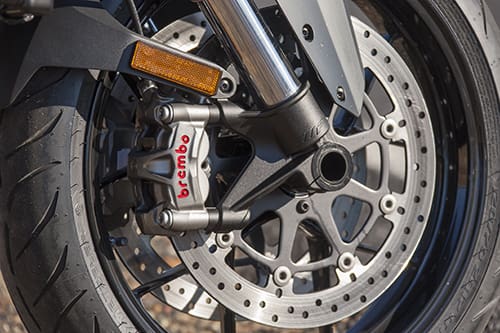
He said, she said
Sam Maclachlan
A 2016 KTM 1290 Super Duke was my personal ride for a couple of years, so I’m a bit biased towards the big Kato. Monster horsepower in a street-friendly engine that just begs to be challenged, the sweet chassis and proper brakes and suspension will always place it among my favourite bikes to ride on the road. It’s fun, effective and can do it all, more comfortably than a lot of its competition. That price though… If KTM could drop $2k, or add the quick shifter, it would be a no-brainer.
Kel Buckley
Flashy and foolhardy, KTM’s Super Duke feels like a supermotard on steroids. The jewel in its crown is its 48mm WP front fork, which offers unrivalled feedback, stability and trust in the front end – handy when you’re being propelled forward by the biggest engine in the nakedbike business. It’s packed full of the latest tech, with a great full-colour TFT dash, top-notch suspension and keyless ignition, though given its price – which is getting up in the very-high $20Ks when you add on-road costs – not having a quickshifter is inexcusable.
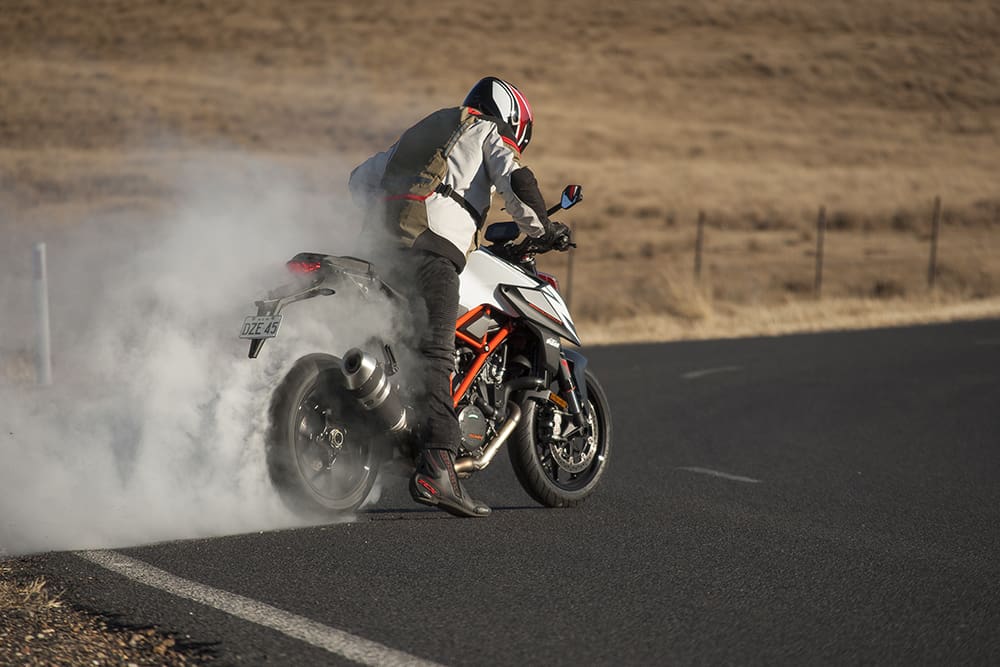
The Wash-up
Whether it’s during a side-of-the-road bike swap, at the bar of an evening or the scramble for a particular key for the ride home once the group disperses, it’s fascinating to see and hear different testers’ very different views on the same group of machinery.
For all of us, the objective stuff is all relatively black and white; comparing the retail price in column A against the list of features in column B is pretty straightforward. And if you’re weighing up the cost effectiveness of your next family car, then an objective, black and white strategy is an effective one.
But motorcycling isn’t like that. It runs far deeper than using simply column A to get to column B, it’s less about sensibilities and strategies and more about sentiments and sensations. And while each motorcycle segment can generally boast a decent range of bikes that can make you feel one way or another, it’s none more so than the big-bore nakedbike category. There’s twins, triples and fours with classic, neo-retro and futuristic styling. Bikes laden with the latest tech, with visionary engineering and with century-old legacies.
But when you peel it all away, when you strip it back to bare metal, the best bikes – the ones that stay with you long after you’ve sold them or moved them on – aren’t always the ones with the longest list of features, or which represent the best value for money. They’re the ones that make you feel the best.
And this bunch of big-bore nakeds returned the very same findings. Sure, the BMW represents astounding value with its capabilities and componentry, and while it was my go-to during the test, Pete was lunging ahead of Sam to get to the KTM’s key fob. But whether its unrivalled look-at-me individuality justifies the extra $4K+ needs to be a decision based on individual circumstances. For others, having seven decades of Indian’s sideways success on oval tracks culminating into one of the most unique and capable nakedbikes on the road will be impossible to pass up.
For now, though, the large-capacity nakedbike segment is alive and well, brimming with a vast range of options, both practical and extravagant, and it bodes very well for the longevity of wholesome two-wheeled tomfoolery.
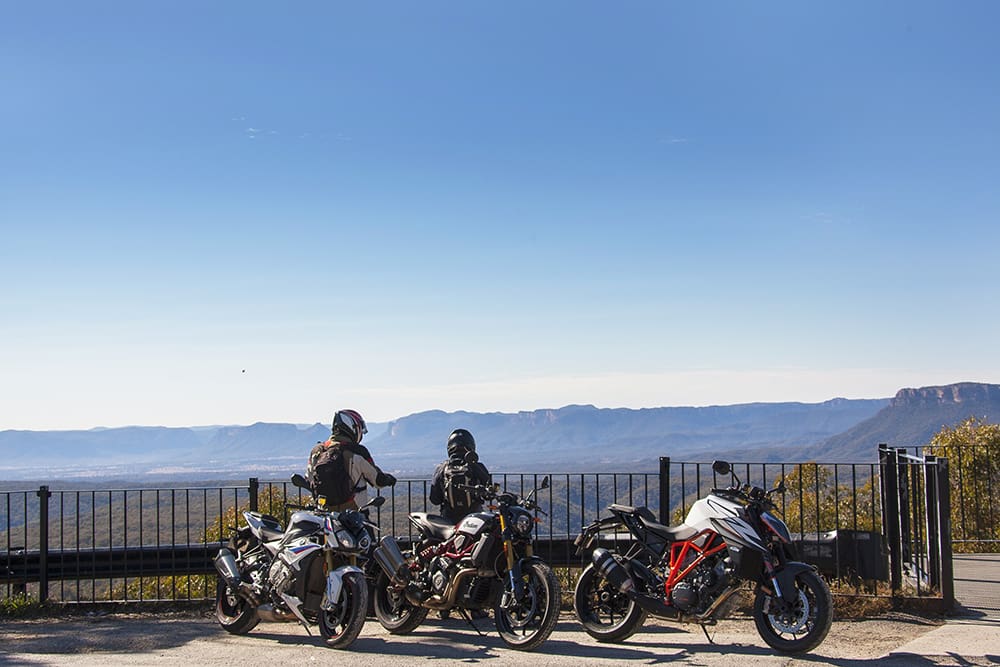
TEST: PETE VORST & KELLIE BUCKLEY PHOTOGRAPHY SAM MACLACKLAN & KB











